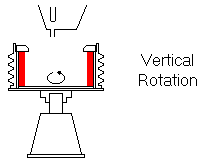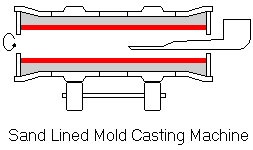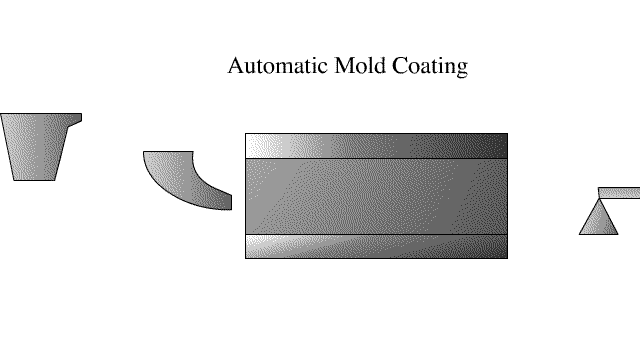|
Centrifugal casting process is specifically adapted to the production of cylindrical parts.
In the centrifugal casting process, molten metal is poured into a hollow cylindrical mold spinning about
a horizontal or vertical axis at high speeds(300-3000 rpm) generating more than 100 Gs of centrifugal force.
The centrifugal force distributes the molten metal and shapes it into a tubular casting. Spinning is
continued until the metal solidifies. Gates, risers and cores are eliminated in this process, resulting
in maximum yield.
Mold may be made of cast iron or steel, copper, graphite, ceramic, or dry sand. The outside surfaces
of the casting or the mold surface can be modified from the true circular shape by the introduction
of flanges or small bosses, but they must be generally symmetrical about the axis to maintain balance.
The inside surface of a true centrifugal casting is always cylindrical.
The axis of rotation may be horizontal, vertical or inclined at any angle up to the vertical position.
The heavy pieces, whose diameter is genreally short compared to the length, are produced
on vertical centrifugal casting machines.
The long pieces are produced on horizontal centrifugal casting machines
The advantages of Centrifugal Casting
Improved physical properties
Formed under pressures many times that of gravity combined with directional solidification, two unique
characteristics of the centrifugal casting process, the products exhibit a denser, closer grained structure,
with absolutely no porosity. Because of high structural uniformity, physical properties such as tensile
strength, yield strength, elongation, reduction of area, and other desirable properties are improved by up
to 30% over conventional gravity or static casting methods.
Longer Life
Parts made from centrifugal process, with the castings’ closer grained, denser structure provide more
reliable service life and withstand greater stress and impact without fracturing.
Due to higher reliability and life of the components produced using this process, total costs over
the life of the end product is much lower due to fewer end-of-life/failure situations and lower maintenance.
Competitive Product Pricing and lower lifetime costs
Our unique insight and in-depth engineering expertise in centrifugal casting process coupled with inherently
low metal wastage characteristics of this process allow us to produce highly reliable products at
competitive pricing as compared with traditional casting methods such as sand casting.
Faster Delivery
Due to the short mold set up and preparation time required for centrifugal castings, delivery can be
scheduled to meet the customer’s needs. The customer benefits from reduced manufacturing lead time and
avoids the high cost of maintaining inventory.
Minimum Developmental Lead-time and Expense
The molds are made in-house at Vijay Spheroidals which minimizes the lead time in developing new items and
on continuous offtake the customers are free of developmental expenses.
Reduced Rejects
As the molten metal is poured, centrifugal forces distribute the molten metal against the walls of
the mold with tremendous force, thereby displacing the lighter oxides and impurities, causing them to
surface on the inside diameter of the hollow cylinder being cast. The trapped oxides and impurities
are easily removed in the machining process.
Production Flexibility
The centrifugal process allows economical production of a diversified range of sizes, shapes and quantities.
Disadvantages
Limitations on shape of castings.
Normally restricted to the production of cylindrical geometric shapes.
|



